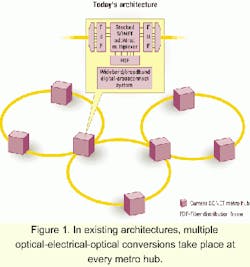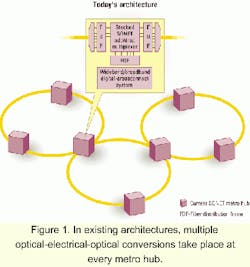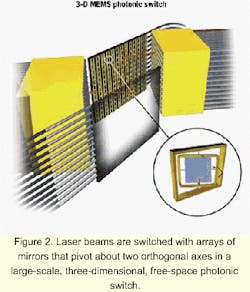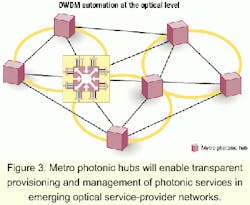Switching to photonics in the metro
The neurons of the new metro networks, photonic switches will control dynamic traffic flows with the speed of today's voice switches.
RAO LINGAMPALLI and LUC CEUPPENS, Calient Networks
The explosive growth of data and Internet traffic is transforming the SONET-based services in metropolitan optical networks into wavelength or fiber-based services. Until recently, metro networks carried voice and low-speed data services that were typically aggregated at two levels using legacy SONET equipment and multiple data-switching systems. Today, the multiservice aggregation functions are increasingly pushed toward customer premises equipment (CPE) with high-speed optical interfaces. Customers are demanding all-optical switched transport, customer-controlled on-demand bandwidth, and speeds ranging from 1 Mbit/sec to 1 Gbit/sec, without expensive signal conversions between the termination points.
SONET-based networks are proving ineffective in delivering ultra-high-speed services. As a result, the industry is witnessing the emergence of a new type of optical service carrier in metro areas. These carriers are taking advantage of photonic switching to offer transparent optical services at the wavelength level. This emerging network architecture combines transparent photonic switching with coarse or dense WDM and full-spectrum fiber to link customers to major hubs or Internet data centers at collocation facilities in metro and regional areas.
The number of businesses using fiber-based access will grow to 450,000 by 2002, fueled by the fiber-rich metro areas established by dark-fiber providers, according to Insight Research. While fiber is abundant and readily available in many markets, most carriers still do not have the capacity to dynamically add new customers. It's a challenge for service providers to turn up services in days, let alone hours. This problem gave rise to collocation facilities and Web hosting centers, in which data local-exchange carriers (DLECs) and others emerged to provide flexible interconnection across metro areas to core transport networks.
In today's fast-changing metro environment, any technical strategy for network evolution must provide for competitive service delivery. As such, legacy-network technologies present severe limitations.
Dark fiber providers and carrier's carriers are deploying multiple cables with hundreds and thousands of strands. And metro DWDM vendors offer 64 wavelengths per fiber. Bandwidth management for thousands of optical signals will be required at metro hubs. This type of support is impossible to achieve in the electrical domain.
The solution is photonic-switching systems, which can be used as a provisioning platform for customers leasing dark fiber or wavelengths at any bit rate, protocol, or format.
All-optical switching systems at metropolitan hubs are designed to satisfy a metro carrier's network requirements: scalability, density, modularity, speed, and protocol transparency in an operating window between 1,260-1,625 nm; rapid provisioning; and low power consumption-all for a cost that scales an order of magnitude below that of existing SONET systems.Metro-network architectures traditionally followed the evolution of voice networking very closely. In the early days, the interconnection of local and long-distance voice switches involved manual crossconnection of DS-1 (1.544-Mbit/sec) circuits. From there, the digital transport hierarchy quickly moved to DS-3 (44.736 Mbits/sec), using M1/3 devices to multiplex switch trunk groups. The manual patch panels and M1/3s were eventually replaced by narrowband, wideband, and broadband digital-crossconnect systems (DCSs and DXCs).
After the standardization of SONET, these systems evolved into SONET DXC grooming switches, which were deployed at various levels to interconnect stacked SONET add/drop multiplexers (ADMs), as shown in Figure 1. This architecture has supported voice-centric metro networks efficiently.
Metropolitan SONET rings are often interconnected using a matched node configuration, in which nodes are interconnected on different unidirectional path-switched and bidirectional line-switched rings. The tributary ports of the matched nodes are interconnected using optical patch panels or SONET DXCs. However, that is not cost-effective, nor is it possible to interconnect two smaller rings to form a single larger ring.
Existing optical-electrical-optical (OEO) architectures do not scale well in data-centric environments. Aggregated trunk speeds on routers have increased sharply from DS-1 to OC-192c (9.953 Gbits/sec), while Ethernet switches have evolved from 10Base-T to Gigabit Ethernet. With interfaces rapidly migrating toward OC-768c (40 Gbits/sec) and 10-Gigabit Ethernet, grooming of these signals using electrical switching fabrics is not cost-effective, scalable, or efficient. Transparent photonic switching is the only viable alternative for flexible optical bandwidth management.
In SONET-based networks, the service and infrastructure layer are inseparable. As a result, protocols such as Internet Protocol (IP), 10-Gigabit Ethernet, Fibre Channel, and Escon cannot be transported without translation to the infrastructure layer. Thus, the traffic requires expensive adaptations such as Gigabit Ethernet over SONET and packet over SONET.
In the search of network traits such as capacity, transparency, scalability, dynamic provisioning, and survivability at the lowest cost of entry, metro carriers are turning to the deployment of metro DWDM systems. The answer to providing high-speed optical metropolitan connections lies in end-to-end wavelength-routed services that deliver end-to-end services with minimal infrastructure and maximum flexibility. In a photonically switched all-optical network, wavelength-routed services will be deployed dynamically, without the need for manual intervention ("truck rolls").
In voice-centric networks, 80% of the traffic originates and terminates in the same local metro area. That is not the case with data-centric networks, where 80% of the traffic is destined for long-haul transport. Nonetheless, several greenfield DLECs are offering native data services such as 100Base-T and Gigabit Ethernet transparent LAN services across metro networks and WANs, at prices comparable to those of DS-1 and DS-3 private lines, improving the price/performance ratio by nearly two orders of magnitude. Other emerging value-added services take advantage of the new photonic technology in carriers' networks.
Photonic virtual private networks (PVPNs) are protocol-agnostic VPNs provisioned using transparent photonic switches. VPNs use shared facilities controlled by software that provides the appearance, functions, and benefits of a private network, including continuous availability and reliability. The VPN service market is expected to reach $36 billion by 2004, from $5 billion in 2001, according to Infonetics Research. PVPNs can be created dynamically in metro or regional areas, irrespective of the underlying protocol. Similar to the way in which residential customers connect to IP VPN providers over DSL connections, business enterprise customers with optical CPE can connect to any end point on the service provider's metro, national, or global photonic network.
Another emerging service involves wavelengths. Wavelength services can be classified as either on-demand or long-term optical services. Wavelength-level bandwidth-on-demand services allow end customers such as Fortune 500 companies and metro service providers to dynamically request transparent light paths with associated service characteristics-duration, channels, connection setup and teardown times, quality of service (QOS), and cost. These services are extremely useful to customers that need to upload or download large amounts of data at specific intervals, or times of day.
Photonic-switching technology with intelligent bandwidth management systems will also enable instant resale and provisioning of bandwidth by fiber-rich metro and long-haul carriers. Large carriers have been trading bandwidth in the form of voice minutes for nearly a century. Carriers in this space now use pooling points-telecom hotels, cyber hotels, collocation facilities, or data centers-where bandwidth is terminated and traded. The bandwidth market, driven by increasing Internet use and electronic commerce, is growing in the range of 25% to 40% per year, according to McGraw-Hill's "Bandwidth Market Report."
Bandwidth trading companies and energy companies with telecom holdings currently trade telecom bandwidth at STS-1 (52-Mbit/sec) increments, but the inability to provision it in real time and connect buyer and seller immediately after the trade is hindering trading at the wavelength level. Bandwidth auction pioneers failed in such attempts in the past because legacy management systems could not ensure bandwidth availability. That will change as carriers begin to incorporate photonic-switching technology into their networks.
This technology will also allow service providers to offer on-demand high-definition entertainment and business services such as pay-per-view video, videoconferencing, and online video games in real time. Gigabit Ethernet access to residential and business customers will remove the existing bottleneck to core networks.
Metro to international carriers recognize that recurring revenues result from retail customers with a variety of service needs and requirements, rather than a few customers buying bulk bandwidth or dark fiber. To satisfy this dynamically changing customer base, service providers require networks with the following characteristics:
- Real-time provisioning. Even if adequate capacity is in place, it can take several weeks for service providers to provision bandwidth and turn up services for customers. As customers' business models depend heavily on provisioning timelines, the service provider that can provision bandwidth in real time will have the competitive edge.
- Service transparency. Unlike SONET add/drop multiplexers (ADMs), which require bit-rate and protocol-dependent interfaces, metro optical carriers have a need for switching equipment that is transparent to bit rate, protocol, format, and wavelength, in an operating window between 1,260 and 1,625 nm. Service providers can then use a single photonic-switching platform to interconnect service and transport equipment.
- Faster return on investment. The price of bandwidth is dropping rapidly compared to the cost of electronic-based equipment such as SONET. Though several alternative metro-network technologies offer cost savings by integrating and simplifying hub architectures, these technologies are a short-term fix and suffer from limitations in scalability, service dependency, and flexibility. A decade ago, each dollar invested in network infrastructure produced more than $10 in return. Today, that has dropped to just $2. In a data-centric environment, network providers need technologies that transport traffic at the lowest possible cost. A transparent photonic metro core supporting a high-capacity service layer accomplishes that most efficiently.
Two technologies have made large-scale photonic-switching systems commercially deployable: three-dimensional (3-D) micro-electromechanical systems (MEMS) and Generalized Multiprotocol Label Switching (GMPLS), a common control-plane protocol.
The development of several photonic-switch technologies occurred in the last two decades, including but not limited to integrated optic, thermo-optic, acoustic-optic, total internal reflection, and liquid-crystal switching. These technologies suffer from a variety of challenges, such as high insertion loss, wavelength dependency, limited scalability, and polarization dependency, which can limit their applicability in telecom networks.
3-D MEMS photonic-switch technology has been embraced by many developers as a viable solution for service providers. It offers the nonblocking, fast-switching, scalability, low insertion loss and crosstalk, and high-service-ability features required by next-generation providers.3-D MEMS-based photonic switches (see Figure 2) offer the benefits of bit-rate, protocol, and wavelength independence between 1,260 and 1,625 nm. As laser beams are spatially and temporally coherent, these devices do not interact when crossed, and hence crossconnection blocking does not occur. This technology also offers polarization independency with very low polarization-mode dispersion and polarization-dependent loss.
Network protection, dynamic restoration, and real-time dynamic service provisioning of wavelengths can be implemented using GMPLS, which combines existing control-plane techniques with point and click provisioning. GMPLS is a suite of signaling and routing protocols that offers common semantics to manage entities like wavelengths, wavebands, fibers, cables, and ducts, as well as packets, cells, and time slots. These protocols enable data network elements such as routers, ATM switches, and SONET/SDH ADMs to dynamically request bandwidth from the photonic layer. Beyond simple advertising and establishment of optical paths through the network, GMPLS includes performance information about the network. The client-layer equipment at the edge of the network can use this information to dynamically request the resources (e.g., wavelengths) available in the photonic layer.
DWDM is proving to be a cost-effective means of increasing the bandwidth of installed fiber plant. However, wavelengths require routing, add/drop, and protection functions, which can only be achieved through the implementation of network-wide management and control capabilities. Current-generation DWDM networks are monitored, managed, and protected within the digital domain, using SONET and its associated support systems. To leverage the full potential of wavelength-based networking, the provisioning, switching, management, and monitoring functions have to move from the digital to the optical domain.
Efficient management of the growing number of traffic-bearing wavelengths at metro hubs is achieved through the deployment of photonic switches. It is increasingly apparent that technical limitations of the existing transmission infrastructure can only be solved in the optical layer by keeping information in the optical domain as long as possible and efficiently managing wavelengths rather than SONET time slots. The challenge is to deliver this optical solution with the intelligence of the existing SONET infrastructure, but without the cost, complexity, and limitations of electrical-to-optical conversions.In initial deployment, photonic-switching systems will play a role similar to today's crossconnects, while exploiting the benefits of optics. Configured as fiber or wavelength switches, these devices will realign large amounts of bandwidth without regard to the attributes of the optical signals being transported.
In time, photonic switches will perform the following functions as the building blocks of metro networks:
- Connection and bandwidth management to provision connections at the optical-channel level and provide wavelength add/drop functions.
- Protection and restoration at the fiber, waveband, and wavelength level. Since photonic switches switch photons (light beams), they support routing and restoration at both the physical fiber and optical wavelength levels.
- Ability to handle local and transit traffic irrespective of bit rate or protocol and provide switching, interconnection, protection, and restoration at the fiber and wavelength level through the use of industry-standard interfaces.
- Routing and interconnection at the fiber, waveband, and wavelength level to displace some fiber patch panels, thus automating the network interconnection process.
- Fast and automated provisioning. Once the individual channels of the DWDM system are wired to the photonic switches, the switches will establish a path through the network on command from a network-management system.
- Reduce capital expenditures by eliminating unnecessary OEO interfaces.
Using photonic switches as basic building blocks, a dynamic, intelligent, scalable, and transparent photonic network can support rapid provisioning and fast restoration of multigigabit services in metro networks. Metro service providers will finally be able to scale their networks to meet even the steepest increases in bandwidth demand, turning this new optical technology into a revenue generator rather than just a way of saving money. Photonic switches will become the neurons of the emerging optical service-provider networks, with the ability to perform switching with the speed and control of today's voice network, making metro networks more responsive to frequent shifts in traffic flows.
Rao Lingampalli is senior technical marketing manager and Luc Ceuppens is senior director of product management and technical marketing for Calient Networks (San Jose, CA).





